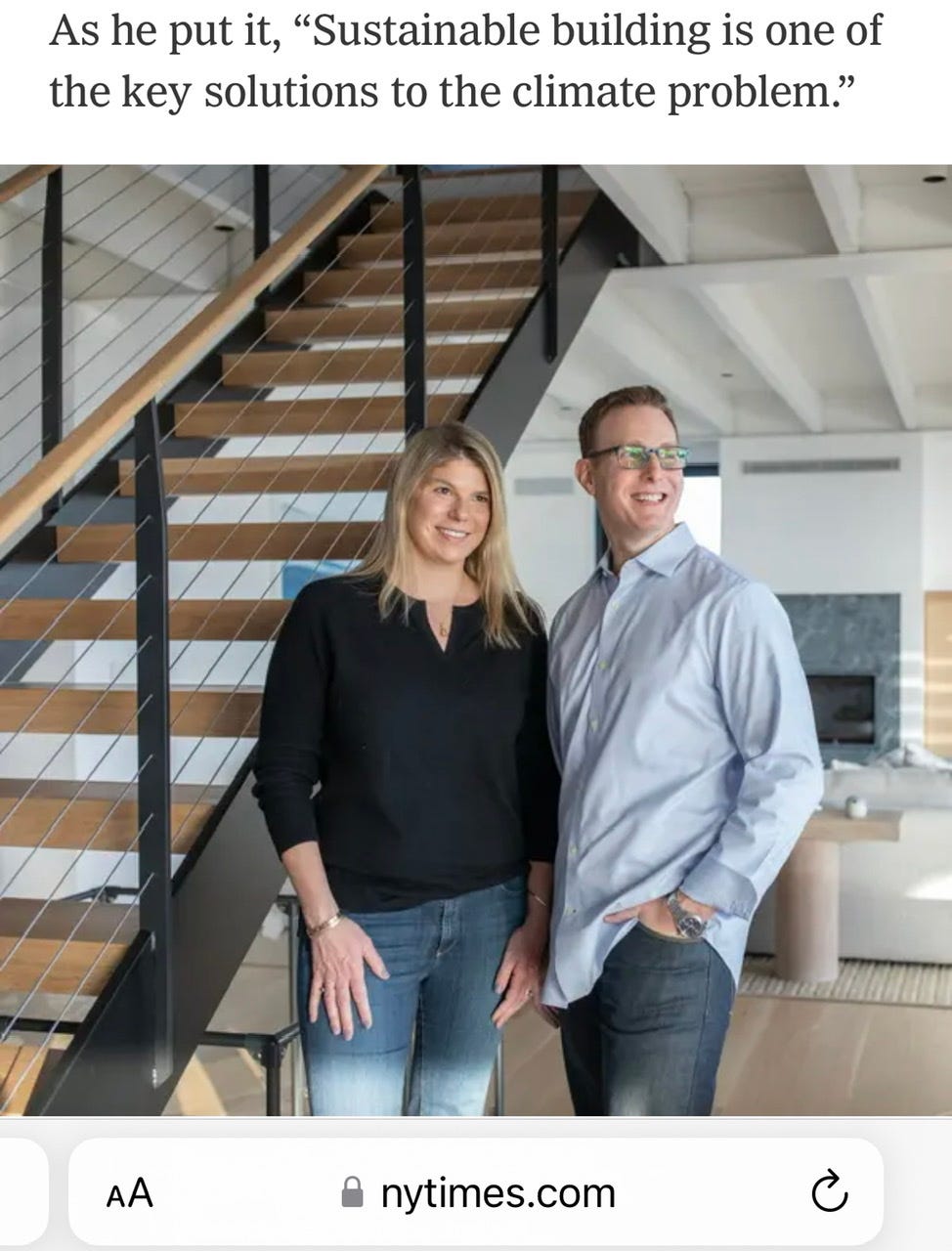Everything you hate about climate change virtue signaling in the most absurd story you’ll read this year
You’re gonna want to read this one on an empty stomach.
Twenty-six times a year, The New York Times shows its commitment to the environment by offering readers “Living Small.”
No, Living Small isn’t about the joys and trials of being height-challenged. It’s “a biweekly column exploring what it takes to lead a simpler, more sustainable or more compact life.”
Seems the Times defines “sustainable” somewhat broadly, though.
Thus today’s Living Small:
Their Cape Cod Home Isn’t Small, but Its Carbon Footprint Is
—
When I saw that headline, I paused to pull on my Tyvek suit before clicking through. I knew the unintentional irony and hypocrisy were about to get thick. But I had no idea how thick.
In 2019, Michael and Jennifer Monteiro dropped $2.6 million on an oceanfront vacation house in Harwich, Massachusetts. Good for them! Michael was just about to sell Buildium, a cutely named software company he had cofounded, for $580 million.
The Monteiros didn’t just want a oceanfront second home, though.
They wanted a oceanfront second home they could feel good about. A oceanfront second home that would tell the world (and themselves) they weren’t merely rich people who owned an oceanfront second home, but thoughtful wealthy people who brought an ethos of sustainability wherever they went, even to their oceanfront second home.
The kind of people who say We’re so lucky. We’re just so lucky, and almost mean it.
—
(Come for the snark, stay for the news. 20 cents a day, vacation home not included.)
—
So the Monteiros spent the next three years working to make their oceanfront second home more energy efficient.
Turns out this was quite the project.
First, they had to demolish it!
Because tearing down a house that’s less than 40 years old is far more environmentally friendly than renovating it. Don’t worry, though, the Monteiros brought in a “material reuse organization to salvage everything worth keeping, and recycled as much of the rest as possible.” (Not including the foundation, they needed a new foundation.)
Then they had to build a new house. And not just any house, “a modern, sustainable house disguised as a traditional shingled cottage.”
—
Disguised indeed. For the Monteiros wanted their new, eco-friendly house to be 6,000-square feet, a mere three times the size of the average American home.
This wasn’t going to be one those 7,000-square foot McMansion monstrosities, people! It would be 6,000, and not a square foot more.
And it was gonna look like a shingled cottage, because that’s classy, even though classy is a word that rich people in blue states never use, never never never, because classy is not actually a classy word. Hey, I don’t make the rules.
And this new house needed hemp insulation, because Mr. Monteiro doesn’t like regular insulation. Alas, Americans don’t usually use hemp insulation. (Red-state savages!)
But the Monteiros found a solution:
They couldn’t find an American installer with the necessary expertise and equipment. Their solution was to assemble a team of French, Canadian and American specialists and import the spray rig from France.
Yes, this family was so committed to saving carbon, it insisted on bringing its own specialized equipment and contractors from thousands of miles away instead of hiring local workers! The Times doesn’t say, but I presume the equipment was flown across the Atlantic on a carbon-free magic carpet.
—
(Can’t you smell the sustainability? Sure you can. It smells like hemp!)

—
A mere two years later, the Monteiros had their dream 6,000-foot disguised cottage.
And how much did all this efficiency cost?
The Times – and the Monteiros – are too modest (too classy!) to give us an exact figure. But they do drop a hint: the project cost about $1,200 a square foot.
So, let’s see, $1,200/square foot * 6,000 square feet = $7.2 million, give or take.
Not counting the furnishings. Because the Monteiros had to buy a bunch of new stuff for their new house! I guess the “material reuse organization” didn’t find much “worth keeping” from the old house.
Never fear, though, they used “renewable, natural materials — cotton, linen, wool, hemp — ” yep, more hemp — and “worked with local manufacturers and craftspeople to produce many of the furnishings, including rugs and sculptural furniture.”
Sculptural furniture?
So it was sculpture? Or it was furniture?
Let’s just hope the “local manufacturers” rode this gravy train for all it was worth.
—
Astonishingly, no one at the Times appears to have been in on the joke.
The article contains not even a hint of the fact that with the possible exception of flying private, nothing is more environmentally ruinous than building a second house. It ends on a high note, as Monteiro shares his heroic dream of leading the masses to hemp-filled homes:
“I don’t expect everybody’s going to want to build with hemp,” he said. “But I hope it causes people to think more about the choices that go into building a house.”
Let’s all hope so.




